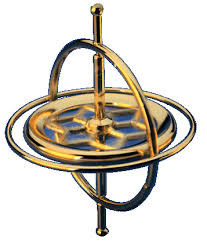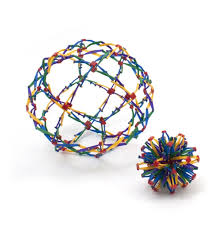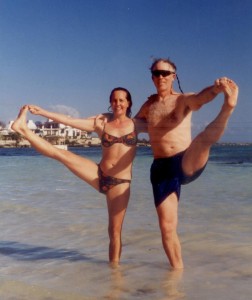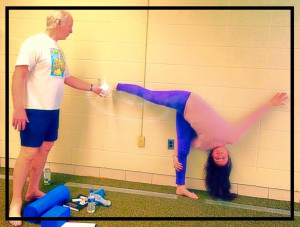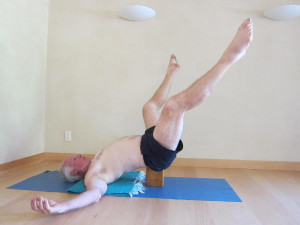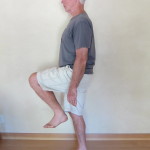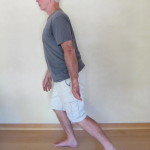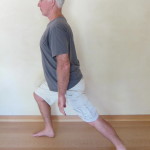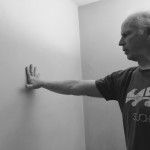Yoga, the Fluid Body and the Dream World.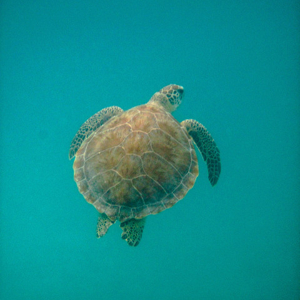
Basic things you should know and be noticing/practicing/exploring so they become integrated and intuitive. We are linking our deepening work in asana and breath with the shamanic/soul/dream practices. You have many lives to work on these so be patient! You are responsible for this life, so be diligent.
Yoga 1: meditation practice resting in the ever-present stillness. Any moment, every moment, any breath, every breath. Being in Nature is helpful.
Yoga 2: Stay awake! There are many layers and levels to discover and explore. Living in ‘unconscious habit’ inhibits creative openings.
Yoga 3: Fully inhabit the divine form of your human body. (See following suggestions (and previous blogs)). We use yoga, but any heart centered somatic practice will do.
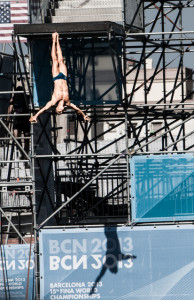 Structure 1: Know your basic anatomy and alignment principles. Start from here and then ‘feel’ your way along.
Structure 1: Know your basic anatomy and alignment principles. Start from here and then ‘feel’ your way along.
Structure 2: Key references in structure for chakras:
1st: K1 (kidney 1 in chinese medicine) in feet, center of perineum, tip of coccyx, legs
2nd: Sacrum, SI joints, Sacral canal
3rd: kidneys, liver, crura of the diaphragm, spleen, stomach, T 9, 10,11,12
4th: point behind the heart,
5th: throat, thyroid, vocal cords, base of pharynx, soft palate
6th: inner ears, top of sinuses, 3rd ventricle
7th: your open crown
Come up with your own personal inner map.
Structure 3: Anatomy Trains Deep Front Line (see Kinesiology 2)
Kinesiology 1: Know the three basic axes of movement through the hips: Mammalian flexion/extension, ie forward and backbends; fish body or lateral flexion/extension ie trikonasana and friends; rotational/spiralic, ie twisting.
Kinesiology 2: Knit and stabilize your core. Use navel as primary reference and link to arms and legs. (see embryology section below.) Glutes and hamstrings must be toned and firing to integrate legs to core. See bridge pose below.
Kinesiology 3: Integrate arms into core through dog pose and variations into inversions.
Kinesiology 4: Differentiate anterior/posterior spine and ascending and descending currents with Bhoga blocks or another rounded support in bridge pose and variations.
Kinesiology 5: Find the fulcrum(s) of your action, (aka ‘continental divide”)
Energy Lines and Fields ‘on the mat’.
1. Radial expanding and condensing (hoberman sphere). this is first fractal in the energy world.
2. Feel the line as opposite radians moving to and from a center.
3. Feel that integration of 1 and 2 create a dynamic spiral field with pulsations.
Energetic fields in Life:
1. Relational Fields: Personal: Emotional fields, Physiological fields, embryological fields (see below) psychological fields, Spirit fields, Soul Fields (see”Dream Work” below)
2. Relational Fields: Human: partners, family, friends, 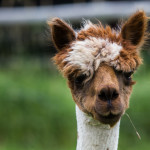 co-workers, people you encounter during the day, Sangha fields, all of humanity. (Note: Some of the most articulate and spiritually profound work on relational fields is being done by Austrian teacher Thoman Huebl.)
co-workers, people you encounter during the day, Sangha fields, all of humanity. (Note: Some of the most articulate and spiritually profound work on relational fields is being done by Austrian teacher Thoman Huebl.)
3. Relational Fields Nature: Pets, other animals, plants, geography (mountains, rivers, ocean, forests etc.
4. Gravity as a Cosmic Field
Embryology 101:
1. Explore navel with imaginal umbilicus and placenta. trace the energy and feel the fields.
2. Find and explore the first emergence of the mesoderm as the fascial plane in the body dividing front from back.
3. Feel the fluidity of your being before the bones emerge. Be oceanic. Channel your inner squid. Dissolve boundaries and merge with the cosmic ocean.
More poses to use for explorations: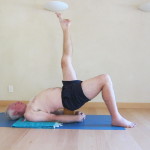
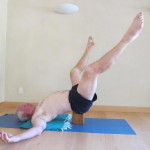
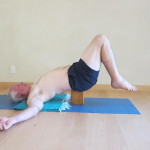 Bridge pose and variations:
Bridge pose and variations: 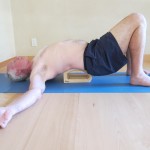 The Bhoga block, seen below, is much more effective than the traditional rectangular block shown above.
The Bhoga block, seen below, is much more effective than the traditional rectangular block shown above.
Spirals: 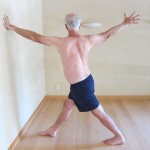 This can be done facing sideways to the wall as well. Find the ascending and descending spirals as a balance of flexion and extension. In seated twists, balance both clockwise and counter-clockwise directions, no matter what direction the outer body is taking. Ask each chakra which way it wants to go. Feel the spirals as waves moving through the fluid body so there is no effort involved. You may be surprised at what happens.
This can be done facing sideways to the wall as well. Find the ascending and descending spirals as a balance of flexion and extension. In seated twists, balance both clockwise and counter-clockwise directions, no matter what direction the outer body is taking. Ask each chakra which way it wants to go. Feel the spirals as waves moving through the fluid body so there is no effort involved. You may be surprised at what happens.
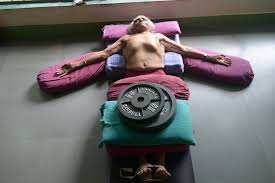 Savasana: This is our entry point into the Imaginal World, aka Dream time. Find the state between waking and sleep and hover there. Beginners either fall asleep, or get lost in thought. Savasana is a bardo state, in between waking and deep sleep. If can learn to remain here, we can begin our explorations in the Imaginal world. This is active dreaming, which is quite different from lucid dreaming, or the dreaming we do after falling asleep.
Savasana: This is our entry point into the Imaginal World, aka Dream time. Find the state between waking and sleep and hover there. Beginners either fall asleep, or get lost in thought. Savasana is a bardo state, in between waking and deep sleep. If can learn to remain here, we can begin our explorations in the Imaginal world. This is active dreaming, which is quite different from lucid dreaming, or the dreaming we do after falling asleep.
Active Dream Explorations: In my on-line studies with Robert Moss, we are developing an ‘architecture’ of dream travel which includes suggestions and imagery that allow the deep imagination to emerge and grow. Deep imagination is the source of all creativity and in our journeying/active dreaming, we hope to unite our personal imagination with the cosmic imagination, the imagination that births the universe. In our work, we create structures, find portals and negotiate with gate-keepers as part of our imaginal journeying. It takes practice to work at this level and the more time we spend here, the easier and more familiar it becomes.
an ‘architecture’ of dream travel which includes suggestions and imagery that allow the deep imagination to emerge and grow. Deep imagination is the source of all creativity and in our journeying/active dreaming, we hope to unite our personal imagination with the cosmic imagination, the imagination that births the universe. In our work, we create structures, find portals and negotiate with gate-keepers as part of our imaginal journeying. It takes practice to work at this level and the more time we spend here, the easier and more familiar it becomes.
A word about the inner skeptic. We love our inner skeptic, as it plays an important role in helping us discriminate and differentiate the layers and meanings of our experiences. However, the skeptic should not be allow to interfere in the journeying, but rather surrender the floor to the imaginal, and at the end of the journey, be available for commentary. Many beginners struggle to open to the active dream world because their skeptic makes too much noise!
In Boston we explored two scenarios I have discovered in my course with Robert:
“Visiting the Library”
Lying in a comfortable position, relaxing muscles, bones and breath, drop into savasana and let the mind deepen and widen. Visualize a library. It can be one you have visited in your life, current, from childhood or college, or you can make one up. But see the building. Notice its architecture, materials, windows, and plantings. Take your time, relax and observe. When you revisit the library on future journeys, there will be some familiar sites and you can stabilize some of the basic structures.
Now see the door, observe it, open it and walk into the library. Look a round a bit. How many rooms are there? How large are they? What color are the walls? Where are the windows? When you find the front desk, you want to ask for a special book, your book, the book that has the story of your life. Once you are familiar with the layout you can go right up to the front desk. The librarian may know immediately where to send you, or may have to look it up. Walk through the library until you find the room with your book. Remember, this is the dream world, so sudden transformations, things appearing and disappearing, one library morphing into a totally different one are all part of the process. It is a very fluid layer of reality.
To find your book, you may have wander around a bit, or climb up or levitate to a top shelf to find it, or it may already be out on a table, but when you do find it, bring to a place where you can open it to a random page and see what is there for you to read. This may be the beginning of another layer of the dream where you are transported somewhere, or where you call in some help to translate or make sense of what your book is saying. Stay in the story for as long as possible. When you return to ‘waking’ consciousness, take some notes, draw pictures, reinforce the imagery. Record in your dream journal.
Visiting the Post Office
Lying in a comfortable position, relaxing muscles, bones and breath, drop into savasana and let the mind deepen and widen. Visualize a Post Office. It can be one form your home town, from a big city any where in the world, or one from your imagination. But see the building. What lets you know it is a Post Office? Notice its architecture, materials, windows, and plantings. Take your time, relax and observe. When you revisit the Post Office on future journeys, there will be some familiar sites and you can stabilize some of  the basic structures.
the basic structures.
Like the library, walk in the door and go up to the counter. You will ask for your ‘undelivered dreams’. Many dreams get sent back because they were unable to be delivered, so you may be giving a huge bin full of undelivered dreams. Take the bin to a place where you can sit and relax and pick one to open. If it is junk mail, put it aside and open another, until something of interest shows up. This begins the second stage where the now delivered dream takes you on another journey. Follow and enjoy for as long as possible. When you return to waking consciousness, take notes, draw pictures, recall the imagery. Record in your dream journal.
In future blogs, as we build the Dream time practices, I will go into more detail how to interpret our experiences. But, first and foremost, the imagery and symbolism of your dreams is unique to you, and only you can truly interpret what they are saying. This is not to say that guidance for one with experience cannot be extremely helpful. It can. And there are many archetypal images and symbols that are relatively universal. But the dream world is uniquely yours. Trust you own intuitions, and be patient.
Photos 1 – 9 courtesy of seankilmurrayphotography.com
Click on colored text for links to related pages on site or on the web.


